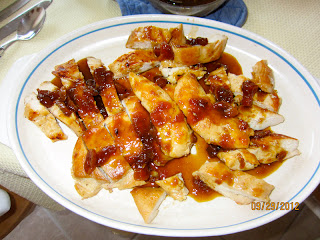Last night we had a dinner guest, Ann Olson, who has not been to our home since 2010. I was given the honor of making the main course. We also had Broccoli Salad which definitely the best recipe ever. It was the recipe I wrote about in the September 20, 2012 blog. Simple boiled red potatoes rounded out the meal with wine of course.
For the glazed chicken breasts I started with the recipe from Cook's Country magazine June/July 2012 issue. But of course I just had to make changes to the recipe. First of all it called for a large skillet and a large baking dish. I chose to use just a large oven proof skillet. the word FOND ("browned bits of chicken that stuck to the skillet" ) seems to be a favorite word for the writers at Cook's Illustrated and Cook's Country. It was not in my 1985 Webster's dictionary.
I also added the brining process and flatten out the breasts to a more uniform thickness. The cooking times where modified to fit the changes I made.
The results were beyond my dreams, in spite of a few goofs.
Here the sauce was pre-made, the the chicken has been flatten out and brined and everything is just waiting for the time to start cooking.
You will notice that there were only two breasts in the skillet. I had to batch the cooking. However, I forgot to add two teaspoons of oil before cooking the second batch of breasts. The FOND was a little blacker than I desired. At the time I thought what a mess. It's going to be a big job to clean up the skillet.
After about 4 -5 minutes the breasts were turned and were then browning on the other side for about two minutes. I removed the chicken from the skillet and poured the apricot sauce mixture into the skillet and like magic the FOND just melted from the bottom of the pan. The acid in the orange and lemon juice was at work.
After the sauce thickened the chicken was add to the sauce in the skillet, and turned to glaze the surface of the meat.
The final results, ready to serve. By slicing up the breasts into smaller portions, people can better judge their desired serving size.
Recipe follows - and it was a winner
À bientôt,
Mr Nut
Apricot-Glazed Chicken Breasts
Modified from an article and recipe from Cook's Country magazine; June/July 2005
Fro blog Sept 30, 2012 revised 11-11-12
Browning the chicken on the stove in a skillet improved the flavor of the chicken. The fond—browned bits of chicken that stuck to the skillet—added valuable flavor to the sauce.
Serves four
The breasts were pounded down to make sure that the chicken cooked evenly, Check the chicken after about 6 minutes to make sure it isn't browning too quickly.
INGREDIENTS
10 ounces apricot preserves
1/2 cup orange juice
3 tablespoons lemon juice
1/4 cup roughly chopped dried apricots
1/8 teaspoon Sea Salt
1/8 teaspoon coarse ground black pepper
4 boneless chicken breasts about 38 ounces
2 teaspoons vegetable oil per batch of browning
INSTRUCTIONS
1 Flatten out the breasts: Place a chicken breast half between 2 pieces of plastic wrap. Using the flat side of a meat mallet, pound meat (smooth side down) lightly, aim for a thickness of about 1/2 inch thick. Work from the center outward. Remove plastic wrap. Repeat with remaining chicken.
2. Brine the chicken for 30 minutes in about one quart of water with 1/4 cup salt dissolved in the water.
3. Adjust the oven rack to the middle position and preheat the oven to 425℉.
4. Whisk the Blue ingredients together in medium bowl.
5. Heat two teaspoons canola oil (for each batch) in large oven proof skillet over medium-high heat until just smoking
6. Place chicken breasts, smooth side down, in skillet, and cook until well browned 4 to 5 minutes. Turn chicken and lightly brown on second side, 2 minutes longer.
7. Remove the chicken and set aside. In the skillet add apricot mixture. Simmer vigorously over high heat, stirring constantly, until thick and syrupy, 3 to 4 minutes. Scrape all the Fond from the sides of the skillet into the sauce.
8. Return the chicken to the oven proof skillet mixing it into the apricot sauce so that all sides are glazed.
9. Put the oven proof skillet with the chicken and sauce in the oven and bake at 425℉, turning chicken halfway through cooking, until thickest part of breast registers 160 degrees on instant-read thermometer, (12 to 16 minutes not sure of this timing). Transfer chicken to platter and let rest 5 minutes. I found it was a good idea to cut the chicken into smaller pieces before serving. Meanwhile, transfer glaze remaining in the skillet into a small bowl. Serve chicken, passing extra glaze separately.






















